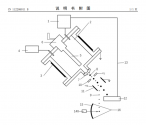A device and method for generating target droplets of euv light source
Abstract
Zhejiang University ZJU (A first)
CN112286011B
2021The present invention relates to a EUV light source target droplet generating device and method. The droplet generating assembly, droplet separation assembly and liquid recovery assembly of the present invention; the droplet generating assembly includes a storage tank, a cavity, a heating device, a pressure source, an excitation module, a disturbance rod and a micro-hole nozzle; the droplet separation assembly includes a belt Orifice electrode plate and deflection electrode plate; liquid recovery assembly including liquid collector. The invention utilizes the principle of Rayleigh instability to generate droplets, and sorts droplets of appropriate size as EUV The target droplet bombarded by the laser light source system of the lithography machine. The target droplet of extremely small size can be obtained, which improves the energy conversion efficiency of laser bombardment of the target droplet; the jet nozzle with a larger size can be used to reduce the manufacturing cost; the target droplet material is recycled and reused to improve the use efficiency and reduce the cost.

